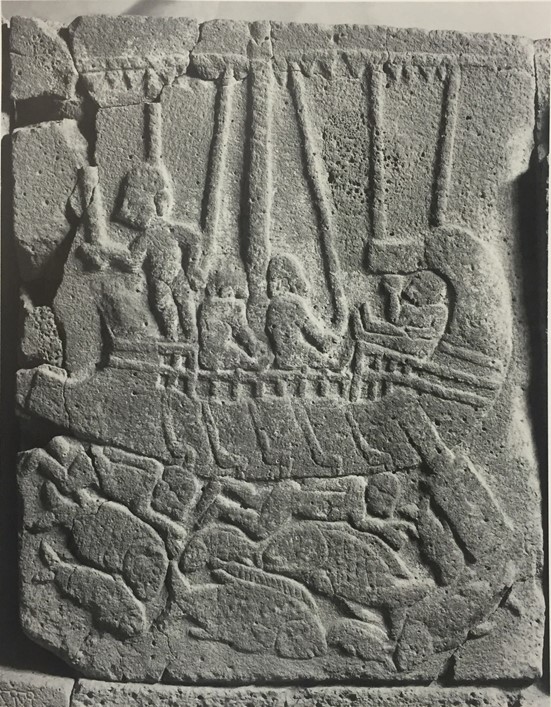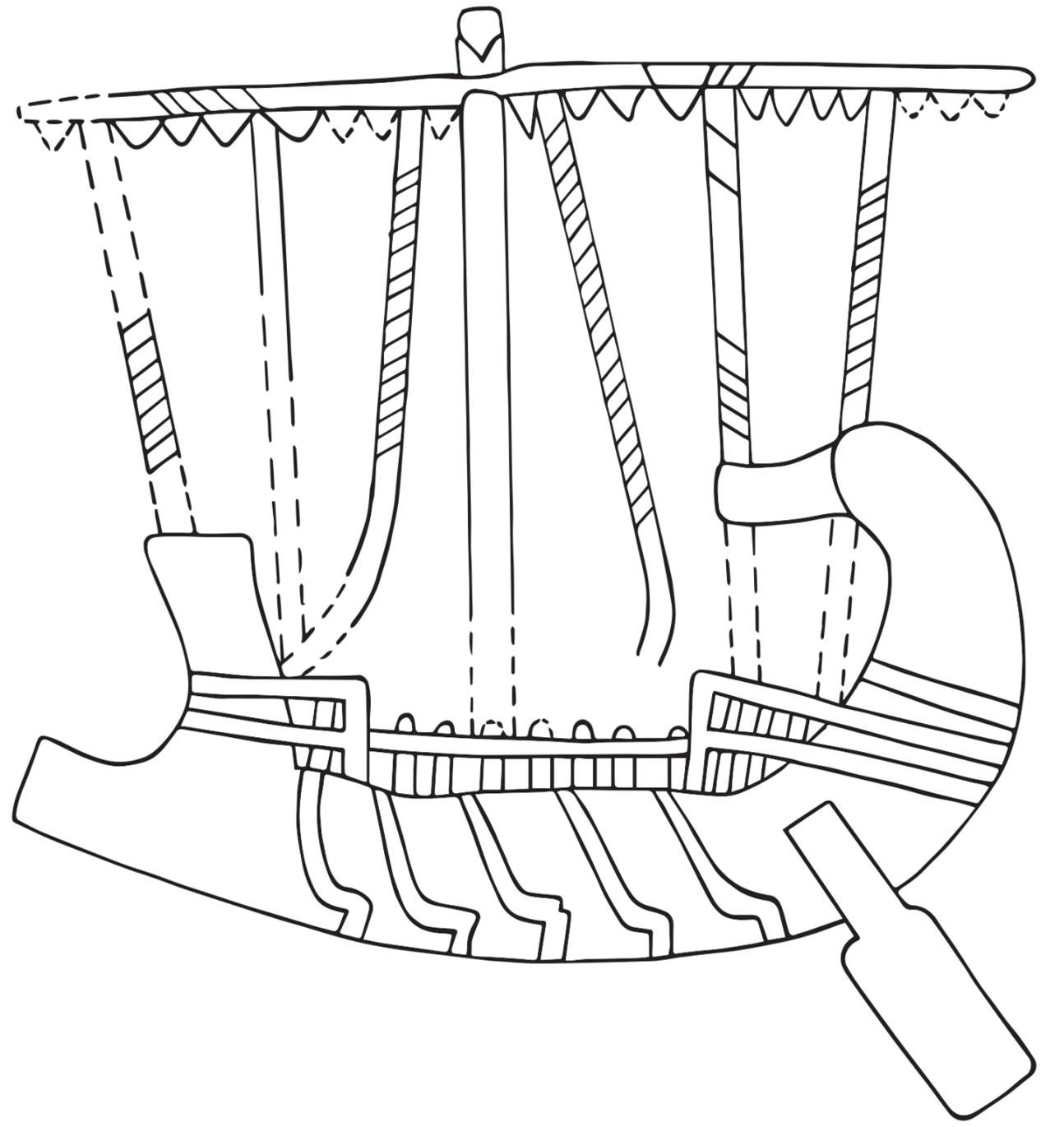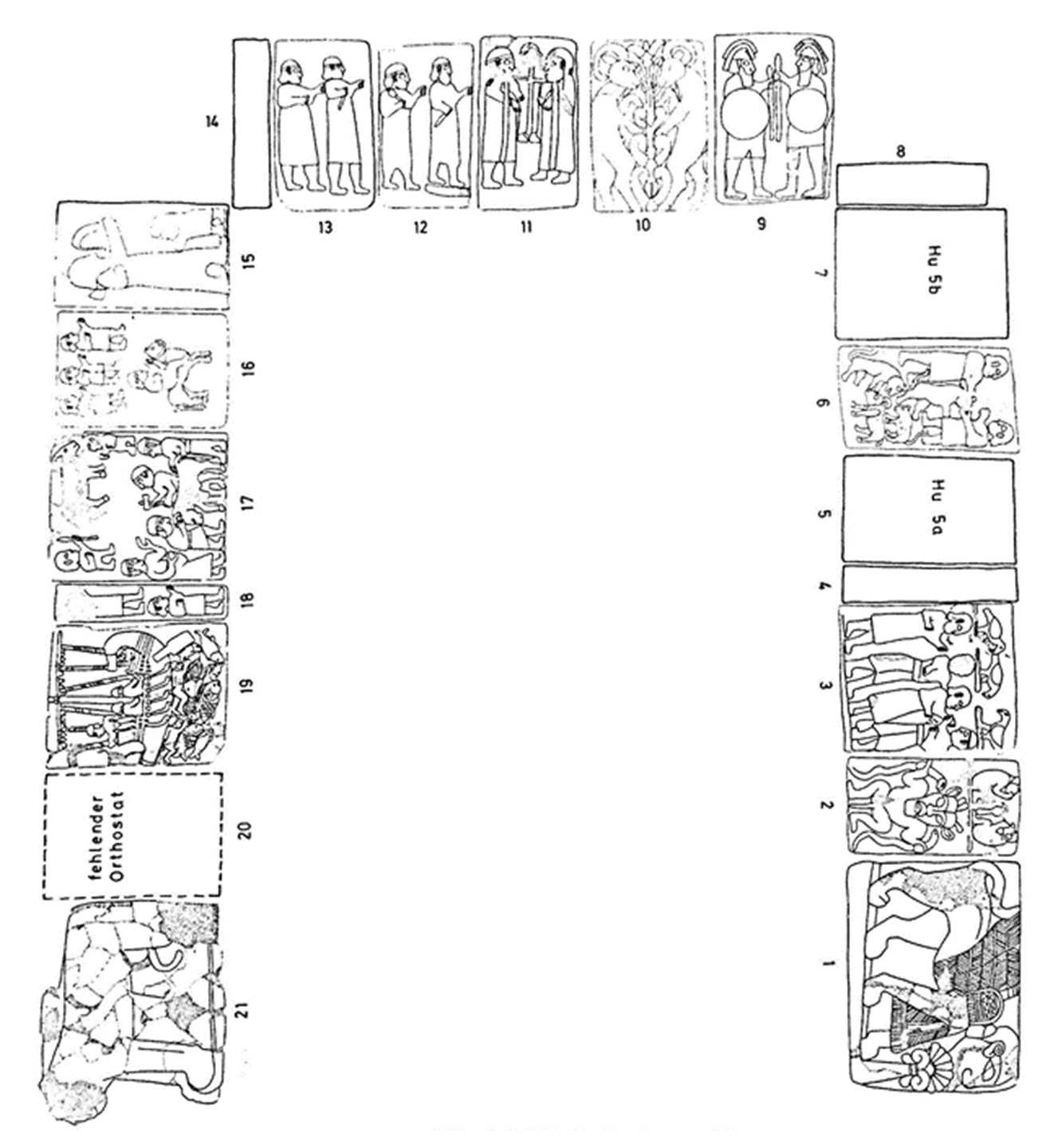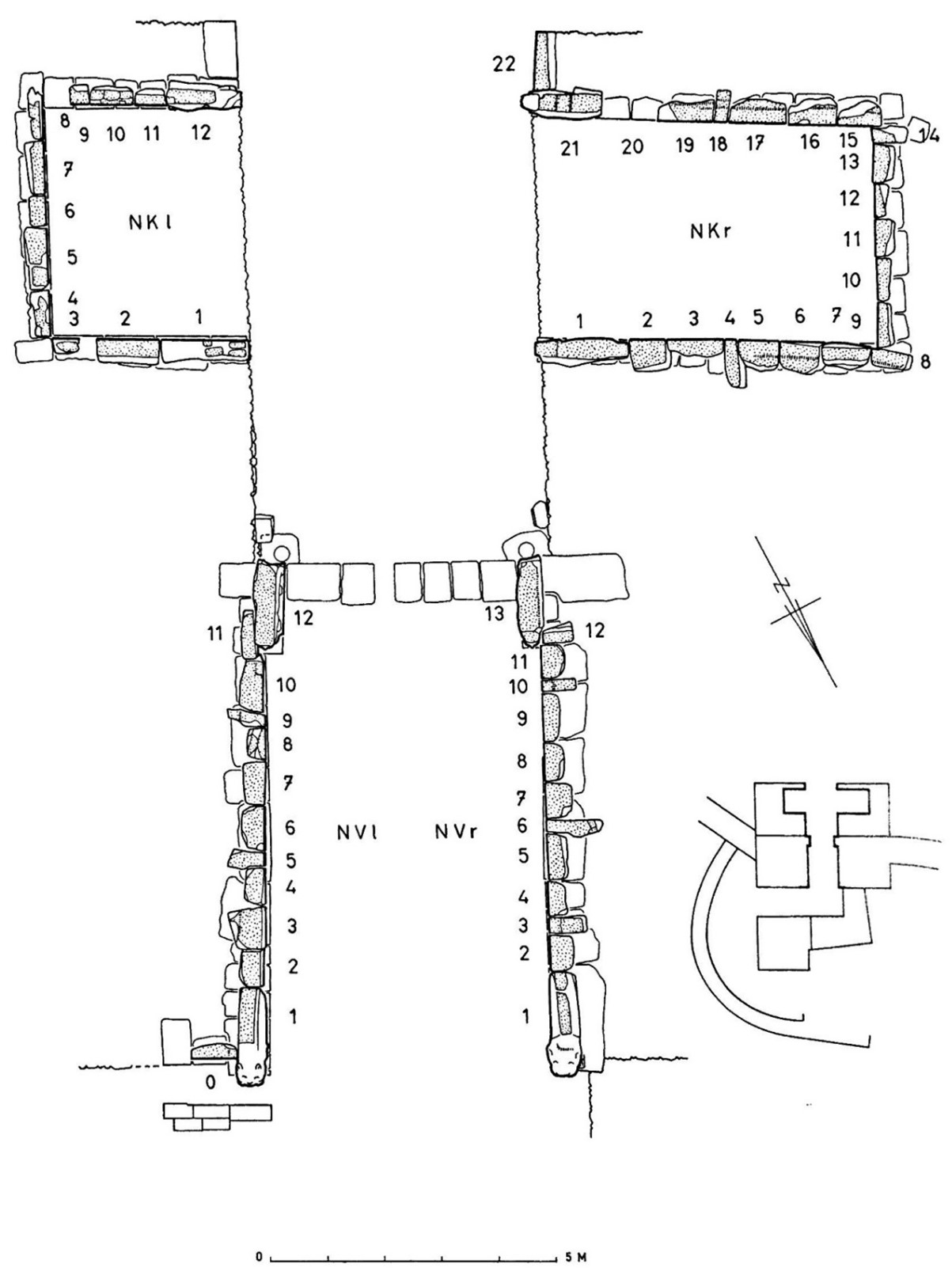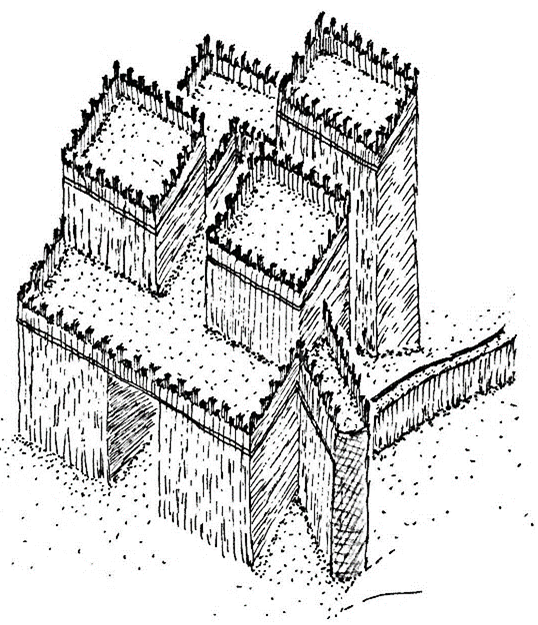Single-levelled ship to the left with a slightly rockered hull. The stempost is concave and thick, resembling a rectangle that inclines slightly forward and lacks a decorative device. The massive, integrated ram is as thick as the hull and ends in a flat rectangular head. As such it is most definitely a functional ram, and is reminiscent of the Atlit ram in that the purpose of ramming is not to pierce but rather to generate a powerful force of impact. The high incurving sternpost preserves the hull's thickness except for its extremity, which bends sharply inwards parallel to the hull and narrows in width significantly. Like the stempost, in ends in a flat rectangular edge. The fore- and aftercastle consist of a rectangular open railing made up of two horizontal wales intersected by vertical stanchions. These wales continue and run across the entire width of the posts to which they are attached. Above the gunwale is a raised railing supported by seven vertical stanchions. The five oars appear as if glued to the hull since they do not extend below the keel line. They are L-shaped, their oar blades bending to the right at a straight angle then bending again sharply down to the keel. Each one is precisely aligned with a rower's "room" framed by two stanchions and spaced out leaving one room vacant in between. The quarter rudder is much thicker, with a massive rectangular oar blade. The mast is amidships, with the yard represented by a straight horizontal that runs the entire length of the ship. The furled sail is denoted by a series of inverted triangles. There are three evenly spaced brails fore and aft. The position of the figures indicates the presence of a deck running down the center of the ship.
Naval battle victory
M13
Late 8th century B.C. (palaeography) with possible reuse of earlier 9th c. material (sculptures)
Karatepe, northeast Cilicia
H: 1.15 m; W: 0.96 m; thickness: 0.43 m
Basalt orthostat with carved relief NKr 19
Basch 1987: 249, no. 526; Bass 1972: 55, fig. 6; ; Brandl and Yahalom-Mack 2022: 245, fig. 5b; Çambel 1948: 155-56, pl. IVb; Çambel and Özyar 2003: 84-89, abb. 4a, 114a-b, taf. 9, 14(2), 67; Casson 1971: 57-58, fig. 79; Frankfort 1954: 186-88; O'Callaghan 1949: 193-99, pl. 27; Orthmann 2008: 246; Özyar 1998; 2003: 112; 2016: 142-145, fig. 6; Wachsmann 1998: 186-187, 190, fig. 8.53; Winter 1979: 120-121; 2008: 474-78, fig. 10
Complex: The site sits on a natural hill on the west bank of the Ceyhan (ancient Pyramos) river, just south of a spur of the foothills that mark the beginning of the juncture of the Taurus and Amanus mountains in the northeastern corner of Cilicia. Access to the citadel was guarded by two monumental T-shaped gate-houses flanked by high towers. An entrance passage between the towers led up to a double-leafed wooden gate leading to two lateral chambers and further into the citadel. A monumental statue of the Storm-God on a double socle and bearing a Phoenician/Luwian inscription stood at the inner entrance of the southwest gate. The approach to each gate was marked by a pair of portal lions, with the North Gate chamber having an additional pair of portal sphinxes. The inner walls of the T-shaped entries and gates houses were furthermore adorned with reliefs carved on basalt orthostats, providing a long sculptural program of ca. 50 reliefs per gate. These portray various themes involving gods and mortals, including banquet scenes, gift bearers and processions, musical events, sacrificial animals, hunting scenes, and some unique compositions such as NKr 19 bearing the ship scene. These were accompanied by a bilingual text in Phoenician and hieroglyphic Luwian - the longest known texts in both languages - that were inscribed on slabs of each gate. The reliefs have been recognized to form two stylistically distinct groups thought to be the product of different workshops or engravers. These furthermore have a clear spatial distribution, with Group A concentrated in the North gate area while Group B is limited to the South gate. The excavators believe that these were nonetheless contemporary, representing a single coordinate construction event involving different workshops. They argue for a late 8th century date, either after the reign of Tiglath-Pileser III or more probably after the death of Sargon II.1 Harrison points out however that there are several lines of evidence that many if not all of the orthostats were originally carved for earlier construction projects. In addition to the fact that there are misfits in various panel joints, he points to the highly disjointed spatial flow of the bilingual inscriptions, with the hieroglyphic texts often encroaching onto adjoining relief panels, which indicates that the narrative portions were added subsequent to the assembly of the figural reliefs. This hypothesis is further strengthened by the diversity of the imagery composed of a wide range of themes assembled in disconnected scenes (Harrison 2009: 49). It is possible therefore that the reliefs were recycled from earlier structures, likely from Karatepe itself, since some of the reliefs appear to date stylistically much earlier to the 9^th^ century. The ceramic assemblage of the site points to an occupation history beginning in the 9th century, and very probably even earlier (Cypriote White Painted Ware and BOR).
1. Lipiński however favours a mid-8th century date for the inscriptions (Lipiński 2004: 117). For references on the diverging opinions on its date, see Green 2010: 234-235, n. 14-17.
Relief NKr 19: The relief with the ship scene is located on the left side of the North gate chamber, immediately following the first slab bearing an inscription which is preceded by the portal sphinx. It belongs in style to Group A as is the case for most of the reliefs of the North Gate. The composition is tightly packed, with a ship to the left taking up the entire width of the slab and the upper two thirds vertically. A nude figure stands on top of the forecastle facing forward, with his right hand pointing forward while his left hand is on his hip. He appears to be on the lookout. Two figures sit on the deck on either side of the mast with their legs outstretched, facing in the opposite direction towards the stern. The second one is holding one of the brails with his right hand. A fourth figure sits on top of the aftercastle with his legs outstretched and holding up a cup in his right hand. He faces towards the bow and appears nested in the narrow space between the aftercastle and the highly incurving sternpost device. Two more figures are either swimming or more likely dead below the ship's hull. Their heads point towards the stern, their chest faces forward while their hips are contorted sideways, with their right leg slightly lifted and bent at the knee. Their left hand is raised, possibly in a gesture of distress. Seven fish of various sizes swim below.
There is no reason to identify the vessel as Aegean as the excavators have argued. Strong Phoenician presence and influence at the site could not be more explicit given the bilingual inscriptions in Phoenician and Luwian. Besides these official documents, there are substantial parallels for various elements of the reliefs that are derived from specifically Phoenician, rather than Syrian or Neo-Hittite iconography, such as peculiar details of the female sphinxes, the Bes figures, and other decorative elements (palmette plants, chains of bud and lotus, interlacing volute (Winter 1979: 121-24). The scene itself is not without ambiguity, although the bodies in the water and the person holding up a cup at the stern seem to suggest the aftermath of a successful battle. The lengthy inscription of Azatiwatas is of no help with its interpretation, since it describes the building of the gates in very general terms and does not mention any naval encounters amongst the deeds of the author. Wachsmann interprets it as a "Phoenician warship,"(Wachsmann 1998: 186) but it is worth noting that there are also obvious influences from the Cypriot nautical tradition.
Basch, L. 1987. Le musée imaginaire de la marine antique. Athens: Institut Hellénique pour la preservation de la tradition nautique.
Bass, G.F. 1972. A History of Seafaring based on Underwater Archaeology. London: Thames and Hudson.
Brandl, B. and Yahalom-Mack, N. 2022. “A Clay Pendant with an Impression of a Phoenician Seagoing Ship from Tel Abel Beth Maacah,” in Davidovich, U. Yahalom-Mack, N. and Matskevich, S. (eds.). Material, Method, and Meaning: Papers in Eastern Mediterranean Archaeology in Honor of Ilan Sharon. Tubingen, pp. 241–252.
Çambel, H. 1948. “Karatepe: An Archaeological Introduction to a Recently Discovered Hittite Site in Southern Anatolia,” Oriens 1.2: 147-162.
Çambel, H. and A. Özyar 2003. Karatepe-Aslantaş: Azatiwataya. Die Bildwerke. Mainz: Philip von Zabern.
Casson, L. 1971. Ships and Seamanship in the Ancient World. Princeton: Princeton University Press.
O'Callaghan, RT. 1949. “The Great Phoenician Portal Inscription from Karatepe,” Orientalia 18: 173-205.
Orthmann, W. 2008. “Aspects of the interpretation of ancient Near Eastern Art as visual communication,” in H. Kühne, R.M. Czichon and F.J. Kreppner (eds.) Proceedings of the 4th International Congress of the Archaeology of the Ancient Near East.Vol.1. Wiesbaden: Harrassowitz Verlag, pp. 243-54.
Özyar, A. 1998. “Die Schiffsszene aus Karatepe-Aslantaş.” Istanbuler Mitteilungen 48: 97-106.
―――. 2003. “Architectural Relief in Anatolia through time: Contextualizing the Gate Sculptures of Karatepe-Aslantas/Azatiwataya,” in B. Fischer, H. Genz, E. Jean and K. Köroglu (eds.) Identifying Changes: the transition from Bronze to Iron Ages in Anatolia and its neighbouring Regions. Istanbul: Türk Eskiçağ Bilimleri Enstitüsü, pp. 107-117.
―――. 2016. “Phoenicians and Greeks in Cilicia? Coining Elite Identity in Iron Age Anatolia,” in J. Aruz, M. Seymour (eds.) Assyria to Iberia: art and culture in the Iron Age. New York: The Metropolitan Museum of Art, pp. 136-146.
Wachsmann, S. 1998. Seagoing Ships & Seamanship in the Bronze Age Levant. College Station, TX: Texas A&M University Press.
Winter, I. J. 1979. “On the Problems of Karatepe: The Reliefs and Their Context,” Anatolian Studies 29: 115-151.



